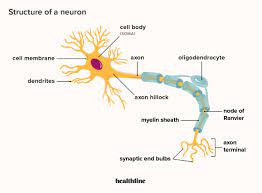
Nervous System Cells
Nervous System Cells (online)
Anatomy and Physiology
Functional Classification of Neurons
Afferent (sensory): conduct impulses from sensory receptors to CNS
Interneuron: process information from afferent neuron, then sends out response
Efferent (motor): conducts outgoing impulses from the interneuron toward effectors (muscles/glands)
Terms
CNS: brain and spinal cord
PNS: nerves in outer regions, spinal and cranial nerves
Afferent nerves: sensory, collect from periphery to send to CNS
Efferent nerves: motor, send information from CNS to periphery
Somatic Nervous system: body and skeletal muscles, carries information to and from voluntary skeletal muscles
Autonomic nervous system: controls involuntary functions, sends out response to visceral (organs) effectors, eg. muscles, glands
Sympathetic nervous system:
Parasympathetic nervous system:
Cells of Nervous system
Neurons
Structure

Dendrites: receiving information from sensory receptors or other nerves, and then information sent to cell body
Nucleus: instructions to govern cell function
Mitochondria: atp for neuron
RER and ribosomes: protein synthesis of neurotransmitters
Cell body(perikaryon or soma): synthesizes material, protein and mitochondria, and material to maintain and regenerate nerve fibers
Axon: nerve fiber/process, takes information away from cell body, sometimes covered in myelin sheath, varies in size
Synaptic Knob: far end of neuron(distal), communicate with gland, muscle, or another nerve
Synapse: area where there is communication between synaptic knob and other effector
Nodes of renvier: in between myelin where axon is exposed, AP jumps from node to node to allow faster transmission
Axon Hillock: information gathers here and then gets sent along axon
Axon collateral: side branches of an axon
Cytoskeleton:
Axonal Transport
Functional Region of Neuron
Input zone: receives the input, includes dendrites and cell body
Summation zone: inputs are combined which generates impulse, includes axon hillock, many voltage gated sodium and potassium channels
Conduction zone: impulse conducts along axon away from cell body, includes axon
Output zone: neurotransmitters are released into a synapse to communicate, include telodendria and synaptic knobs of axon, has many voltage gated calcium channels
Glia Cells in CNS (Neuroglia)
Microglia
Ependymal Cells
Oligodendrocytes
Astrocytes
Glia Cells in PNS- Shwann cells
Myelinated axon appearance in PNS
Myelin: plasma membrane of shwann cells, made of white fatty substance (phospholipid), forms sheath around nerve axon
Myelin Sheath: the inner core made of many layers of myelin
Nodes of Ranvier: gaps in myelin sheath, faster conduction
Neurilemma: where the nucleus and cytoplasm of shwann cell is located at perimeter, essential for growth
Neurolemmocyte: another name for shwann cell
Neuronal sheath: both the myelin sheath and neurilemma surrounding nerve axon/fiber
Nerves and Tracts
CNS
PNS
Gray matter
Note
Connective tissue coverings of nerves in PNS
Endoneurium
Perineurium
Epineurium
Repair of Nerve Fibers
Nervous System Cells (online)
Anatomy and Physiology
Functional Classification of Neurons
Afferent (sensory): conduct impulses from sensory receptors to CNS
Interneuron: process information from afferent neuron, then sends out response
Efferent (motor): conducts outgoing impulses from the interneuron toward effectors (muscles/glands)
Terms
CNS: brain and spinal cord
PNS: nerves in outer regions, spinal and cranial nerves
Afferent nerves: sensory, collect from periphery to send to CNS
Efferent nerves: motor, send information from CNS to periphery
Somatic Nervous system: body and skeletal muscles, carries information to and from voluntary skeletal muscles
Autonomic nervous system: controls involuntary functions, sends out response to visceral (organs) effectors, eg. muscles, glands
Sympathetic nervous system:
Parasympathetic nervous system:
Cells of Nervous system
Neurons
Structure

Dendrites: receiving information from sensory receptors or other nerves, and then information sent to cell body
Nucleus: instructions to govern cell function
Mitochondria: atp for neuron
RER and ribosomes: protein synthesis of neurotransmitters
Cell body(perikaryon or soma): synthesizes material, protein and mitochondria, and material to maintain and regenerate nerve fibers
Axon: nerve fiber/process, takes information away from cell body, sometimes covered in myelin sheath, varies in size
Synaptic Knob: far end of neuron(distal), communicate with gland, muscle, or another nerve
Synapse: area where there is communication between synaptic knob and other effector
Nodes of renvier: in between myelin where axon is exposed, AP jumps from node to node to allow faster transmission
Axon Hillock: information gathers here and then gets sent along axon
Axon collateral: side branches of an axon
Cytoskeleton:
Axonal Transport
Functional Region of Neuron
Input zone: receives the input, includes dendrites and cell body
Summation zone: inputs are combined which generates impulse, includes axon hillock, many voltage gated sodium and potassium channels
Conduction zone: impulse conducts along axon away from cell body, includes axon
Output zone: neurotransmitters are released into a synapse to communicate, include telodendria and synaptic knobs of axon, has many voltage gated calcium channels
Glia Cells in CNS (Neuroglia)
Microglia
Ependymal Cells
Oligodendrocytes
Astrocytes
Glia Cells in PNS- Shwann cells
Myelinated axon appearance in PNS
Myelin: plasma membrane of shwann cells, made of white fatty substance (phospholipid), forms sheath around nerve axon
Myelin Sheath: the inner core made of many layers of myelin
Nodes of Ranvier: gaps in myelin sheath, faster conduction
Neurilemma: where the nucleus and cytoplasm of shwann cell is located at perimeter, essential for growth
Neurolemmocyte: another name for shwann cell
Neuronal sheath: both the myelin sheath and neurilemma surrounding nerve axon/fiber
Nerves and Tracts
CNS
PNS
Gray matter
Note
Connective tissue coverings of nerves in PNS
Endoneurium
Perineurium
Epineurium
Repair of Nerve Fibers